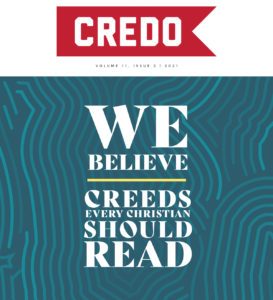
The Chalcedonian Definition: Christ’s Two Natures
T he new issue of Credo Magazine focuses on the creeds of the Christian Faith. The following is an excerpt from one of the issue’s featured articles by Donald Fairbairn. Fairbairn is the Robert E. Cooley Professor of Early Christianity at Gordon Conwell Theological Seminary. His research interests focus on the relation between the doctrines of the Trinity, Christ, salvation, and the Christian life in the early church, especially in the 4th through 6th centuries.
he new issue of Credo Magazine focuses on the creeds of the Christian Faith. The following is an excerpt from one of the issue’s featured articles by Donald Fairbairn. Fairbairn is the Robert E. Cooley Professor of Early Christianity at Gordon Conwell Theological Seminary. His research interests focus on the relation between the doctrines of the Trinity, Christ, salvation, and the Christian life in the early church, especially in the 4th through 6th centuries.
The first thing one should notice from the title of this post is that the document produced at the Council of Chalcedon in October 451 was not a “creed”; it was a “definition.”
A creed, properly speaking, is not a statement of what Christians believe about our faith. (That would be a “confession.”) Instead, a creed is a pledge of allegiance to the Father, the Son, and the Holy Spirit. Creeds answer the question, “In whom do you believe?” more than the question “What do you believe?”
Creeds were originally intended for liturgical use, as the people of God affirmed their allegiance to the persons of the Trinity prior to baptism or the celebration of the Eucharist. In contrast, a definition is a commentary on a creed, designed to give more terminological precision to the content of that creed.
The Council of Chalcedon
At the Council of Chalcedon (the Fourth Ecumenical Council in the Greco-Roman world), the bishops who assembled were firmly convinced that the Nicene Creed was sufficient to affirm their faith in God, his Son, and his Spirit.Creeds were originally intended for liturgical use, as the people of God affirmed their allegiance to the persons of the Trinity prior to baptism or the celebration of the Eucharist. Click To Tweet
They were right: the Nicene Creed clearly identifies each of the divine persons, shows that they are equal to one another, and emphasizes that for us and for our salvation, the Son came down from heaven through the incarnation. At the same time, the bishops at Chalcedon were under intense pressure from the emperor to produce a new creed, because he wanted to be able to call himself a new Constantine, presiding over the writing of a creed as Constantine had done at Nicaea in 325. The bishops also recognized that they needed more specificity than the Nicene Creed gave about how to understand Christ as both divine and human. As a result, they decided to write not a creed, but a “definition.”
Contrary to popular opinion, the Chalcedonian Definition is actually about five pages long—far too long to recite as part of a worship service. It includes the full text of two different versions of the Nicene Creed: the original form from the First Ecumenical Council at Nicaea in 325, and the expanded version (the one familiar to us) from the Second Ecumenical Council at Constantinople in 381.
It includes descriptions of heresies that had arisen since 381 (Nestorianism—which regarded Christ not as God the Son incarnate but as a man inspired by God, and Eutychianism—which truncated the full humanity of the incarnate Son by refusing to accept his consubstantiality with us). Then the Definition concludes with a paragraph that gives specificity and terminological precision to the church’s articulation of the incarnate Christ. This paragraph is usually regarded mistakenly as being the entire definition, but with that mistake duly noted, it is still worth our while to read and consider that paragraph.
The Text
As I translate it, the paragraph reads as follows:
Therefore, following the holy fathers, we all unite in teaching that we should confess one and the same Son, our Lord Jesus Christ. This same one is perfect in deity, and the same one is perfect in humanity; the same one is true God and true man, comprising a rational soul and a body. He is of the same essence (homousios) as the Father according to his deity, and the same one is of the same essence (homousios) with us according to his humanity, like us in all things except sin. He was begotten before the ages from the Father according to his deity, but in the last days for us and our salvation, the same one was born of the Virgin Mary, the bearer of God (Theotokos), according to his humanity. He is one and the same Christ, Son, Lord, and Only Begotten, who is made known in two natures (physeis) united unconfusedly, unchangeably, indivisibly, inseparably. The distinction between the natures (physeis) is not at all destroyed because of the union, but rather the property of each nature (physis) is preserved and concurs together into one person (prosopon) and subsistence (hypostasis). He is not separated or divided into two persons (prosopa), but he is one and the same Son, the Only Begotten, God the Logos, the Lord Jesus Christ. This is the way the prophets spoke of him from the beginning, and Jesus Christ himself instructed us, and the Council of the fathers has handed the faith down to us.
**Read the remainder of Donald Fairbairn’s article in the latest issue of Credo Magazine.

